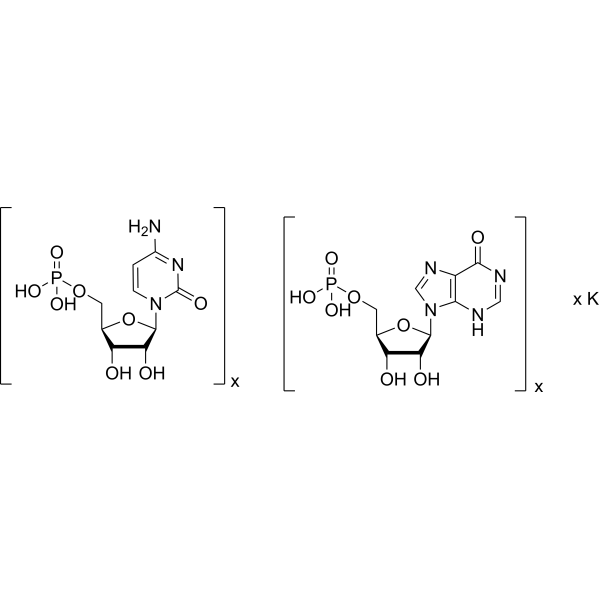Polyinosinic-polycytidylic acid potassium

Polyinosinic-polycytidylic acid potassium structure
|
Common Name | Polyinosinic-polycytidylic acid potassium | ||
|---|---|---|---|---|
| CAS Number | 31852-29-6 | Molecular Weight | 710.5 | |
| Density | N/A | Boiling Point | N/A | |
| Molecular Formula | (C10H13N4O8P)x.(C9H14N3O8P)x.xK | Melting Point | N/A | |
| MSDS | USA | Flash Point | N/A | |
Use of Polyinosinic-polycytidylic acid potassiumPolyinosinic-polycytidylic acid potassium (Poly(I:C) potassium) is a synthetic analog of double-stranded RNA and an agonist of toll-like receptor 3 (TLR3) and retinoic acid inducible gene I (RIG-I)-like receptors (RIG-I and MDA5). Polyinosinic-polycytidylic acid sodium can be used as a vaccine adjuvant to enhance innate and adaptive immune responses, and to alter the tumor microenvironment. Polyinosinic-polycytidylic acid potassium can directly trigger cancer cells to undergoApoptosis[1][2][3]. |
| Name | POLYINOSINIC-POLYCYTIDYLIC ACID POTASSIUM SALT |
|---|---|
| Synonym | More Synonyms |
| Description | Polyinosinic-polycytidylic acid potassium (Poly(I:C) potassium) is a synthetic analog of double-stranded RNA and an agonist of toll-like receptor 3 (TLR3) and retinoic acid inducible gene I (RIG-I)-like receptors (RIG-I and MDA5). Polyinosinic-polycytidylic acid sodium can be used as a vaccine adjuvant to enhance innate and adaptive immune responses, and to alter the tumor microenvironment. Polyinosinic-polycytidylic acid potassium can directly trigger cancer cells to undergoApoptosis[1][2][3]. |
|---|---|
| Related Catalog | |
| Target |
TLR3 |
| In Vitro | Polyinosinic-polycytidylic acid potassium (20 ng/mL; 24 hours; WM793, WM278, WM239A, WM9 and 1205Lu cells) 抑制细胞生长活性[1]. Polyinosinic-polycytidylic acid potassium (200 ng/mL; 24 hours; 1205Lu cells) 诱导 1205Lu 细胞凋亡[1]。 Polyinosinic-polycytidylic acid potassium (5 ng/mL; 24 hours; 1205Lu cells) 诱导黑素瘤细胞中的 IFN-β 表达。RIG-I 和 MDA-5 的沉默证实 Polyinosinic-polycytidylic acid potassium 诱导 IFN-β 分别需要 RIG-I 和 MDA-5,并且需要 IPS-1[1]。 Polyinosinic-polycytidylic acid potassium 重悬于无菌盐水中,以 2 mg/ml 的浓度加热至 50 °C 以确保完全溶解,然后自然冷却至室温以确保双链 RNA 的适当退火,从而制备用于注射的 Polyinosinic-polycytidylic acid potassium. Poly I:C 储存在 -20 °C 直至使用[3]。 Cell Viability Assay[1] Cell Line: WM793, WM278, WM239A, WM9 and 1205Lu cells Concentration: 20 ng/mL Incubation Time: 24 hours Result: Strongly reduced viability from 100% in controls to 20%–50% within 24 hours. Apoptosis Analysis[1] Cell Line: 1205Lu cells Concentration: 200 ng/mL Incubation Time: 24 hours Result: Induced apoptosis in 1205Lu cells. RT-PCR[1] Cell Line: WM793, WM278, WM239A, WM9 and 1205Lu cells Concentration: 3 ng/mL Incubation Time: 24 hours Result: Induced IFN-β expression in melanoma cells. Western Blot Analysis[1] Cell Line: 1205Lu cells Concentration: 5 ng/mL Incubation Time: 24 hours Result: Revealed active subunits of caspase-9 and caspase-8 in melanoma cells. |
| In Vivo | Polyinosinic-polycytidylic acid potassium (50 µg; i.v.; on days 3, 6, and 9 after tumor inoculation) 在 NOD/SCID 免疫缺陷小鼠中显示出抗肿瘤活性[1]。 Animal Model: NOD/SCID immunodeficient mice (1205Lu cells)[1] Dosage: 50 µg Administration: I.v.; on days 3, 6, and 9 after tumor inoculation Result: Reduced the size of metastases and the total amount of tumor tissue, and the level of human DNA was 50% lower in mice. |
| References |
| Molecular Formula | (C10H13N4O8P)x.(C9H14N3O8P)x.xK |
|---|---|
| Molecular Weight | 710.5 |
| Storage condition | −20°C |
| Personal Protective Equipment | Eyeshields;Gloves;type N95 (US);type P1 (EN143) respirator filter |
|---|---|
| Hazard Codes | Xi |
| RIDADR | NONH for all modes of transport |
|
The interaction between maternal immune activation and alpha 7 nicotinic acetylcholine receptor in regulating behaviors in the offspring.
Brain. Behav. Immun. 46 , 192-202, (2015) Mutation of human chromosome 15q13.3 increases the risk for autism and schizophrenia. One of the noteworthy genes in 15q13.3 is CHRNA7, which encodes the nicotinic acetylcholine receptor alpha 7 subun... |
|
|
How reliable are sino-nasal cell lines for studying the pathophysiology of chronic rhinosinusitis?
Ann. Otol. Rhinol. Laryngol. 124 , 437-42, (2015) Well-characterized cell lines represent useful scientific tools to study the pathophysiology of human disease. Chronic rhinosinusitis (CRS) is a very common condition, though the number of CRS cell li... |
|
|
RIP3-mediated necrotic cell death accelerates systematic inflammation and mortality.
Proc. Natl. Acad. Sci. U. S. A. 112 , 11007-12, (2015) Systematic inflammation contributes to the development of many diseases, including cardiovascular disease, which is the leading cause of mortality worldwide. How such inflammation is initiated and mai... |
| MFCD00131983 |